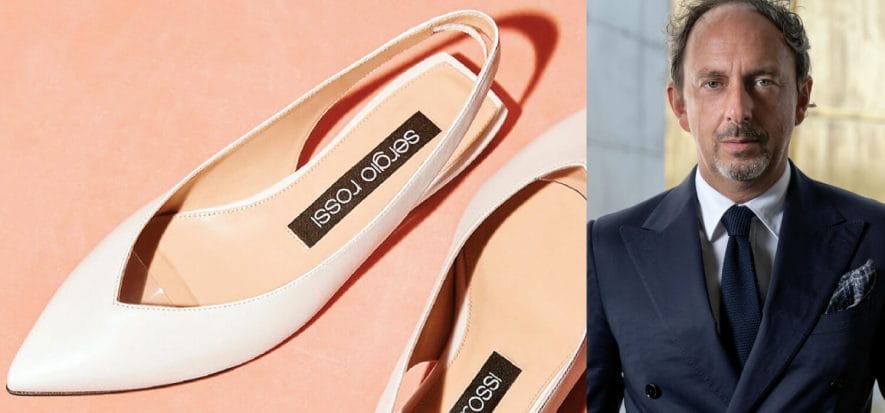There are several reasons to explain Sergio Rossi‘s move to Fosun Fashion Group. First of all, the Chinese fund put the factory at the centre of the project, ensuring the expansion of production and employment. In addition, the new partner supports an ambitious investment plan of distribution in Asia. Riccardo Sciutto explains it to us, reconfirmed in the role of CEO of the brand, but also as a new minority shareholder. Sciutto (pictured) reveals some background facts that led to the sale of the company to FFG.
Sergio Rossi’s move to Fosun
What changes now in Sergio Rossi?
What changes is that there is a partner, even an industrial one, which is powerful in the markets of China and Japan, which together are worth over 50% of our turnover. And that’s the right thing for us to do. In general, 50% of Made in Italy is sold in China, 10% in Japan and 5% in Asia. Only 30% is located in Europe and the States, so I have to hope to find a partner, as I have found, who will help me sell a lot all over the world, producing in Italy.
What changes is that you go from being a manager to now being an investor…
I come from a family of entrepreneurs. For me, it is a fantastic closure of a cycle which I get to after rebuilding the factory, which is at the centre of the project, and conquered Asia.
So you don’t mind, as an Italian, ending up under Chinese control?
As a matter of fact, Sergio Rossi has not been Italian since 1999. And today, it is more Italian than before, since I am a partner. Furthermore, the positive aspect, which I wanted to defend, is the made in Italy production. We employ 200 workers out of a total workforce of 420, and produce over 1,000 pairs of shoes per day. Everyone knew that I would choose the best for the factory and the made in Italy.
So do you think you have chosen the best partner?
As long as I am there, I will defend the made in Italy to the end. I learned it at Pomellato and Tod’s. After this crisis, we have few things to defend in Italy: the ability to know how to do things, the craftsmanship, then the managerial skills, and tourism. When I met FFG’s president I asked him: why do you want to buy? He replied that he does it for the factory, for the know-how of the artisans, and for the archive. Then for me and my team. Well, I replied, then the plan is to develop the Chinese market and hire in Italy.
Will the factory, as you call it, remain Sergio Rossi’s strength?
That’s for sure. I’m the guarantor. There were subjects, including Italian ones, interested in taking over the company: they wanted to focus on finance and commercial business. But I don’t throw away my main asset. I have to get along with anyone who share this philosophy, regardless of their nationality. If they take away the craftsmanship, the best brains, what are we left with in Italy?
How will the factory evolve?
We will accelerate the pace by producing for other FFG-controlled brands. But, beware, the factory is not just a manual conveyor: it is a platform also made up of services. Amina Muaddi, for example, comes with a drawing, and we do everything else, including billing and one-to-one delivery. This way, the factory is transformed into a service pole.
So will you focus on services?
From a production point of view, I feel well equipped. On the one hand, up to the sample, we make the shapes internally, by hand and in wood. But we have 3D for the design. 3D is sustainability, because it reduce waste and time. So, I plan to make investments to evolve on services and to reach a goal: the factory talking to the end customer. This is Italy’s challenge in the coming years in all sectors.
For how many brands does it produce?
Today, we are focused on Sergio Rossi and Amina Muaddi, which boasts important volumes. I believed it before others. I believed in young people, as did Sergio Rossi, who trusted Dolce & Gabbana and Versace before they became today’s giants. So far, we have done two days of layoffs, and we are in full production: there will be an accelerated decision.
Will leather remain central to the collections?
Clearly. For over 2,000 years, leather has been a waste from the food industry. Tanning is a fantastic example of circularity. We eat meat, and use the resulting leather to warm our feet. Anyone who says the opposite must explain this to me: if we don’t reuse leather, what shall we do with it? Shall we throw it in the fields? I take it for granted that the reuse and tanning process is well done. Let’s not forget, among the virtues of leather, the durability it gives to the final product, when it has quality. And who makes quality shoes? Us, Italians.
A personal memory related to leather?
After 13 years of not entering the company, I invited Sergio Rossi to show him the archive named after him. He takes out the hides, touches them and I see him feel the memories resurface. It is as if in the leather, there was his whole history, his whole life. I remember his hands, with his fingertips going back in time.
Read also:
- Plot twist: Sergio Rossi acquired by the Chinese Fosun Group
- Was a Chinese super luxury group born with Sergio Rossi in Fosun?










